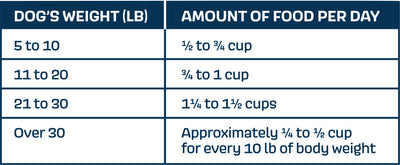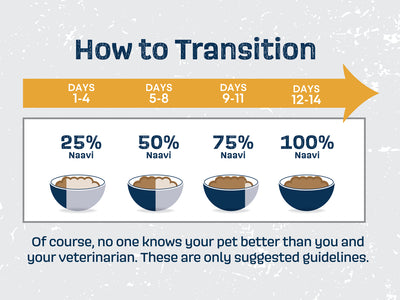Frequently Asked Questions
Choose a category to learn more.
Feeding with Love
Naavi was founded in 2021 with the mission of raising the standards for pet food through expertly formulated recipes developed over two years. Our nutrition-focused philosophy is backed by a team that includes a PhD board-certified nutritionist and five experts with master's degrees in animal nutrition, all boasting over a century of combined experience in the pet food industry. We use a unique blend of meat and plant proteins to create balanced formulations that cater to the omnivorous diets dogs require. This innovative approach places a greater emphasis on the balance of multiple protein sources rather than relying on a single ingredient. Proudly, Naavi meets 11 nutritional standards in our guaranteed analysis and is the first pet food brand to utilize a slow-roasted cooking method, enhancing palatability and nutrient retention.
What size dog is Naavi suitable for?
Naavi Slow Roasted Bowls provide a nutritionally balanced meal for adult dogs of all breeds and sizes. While our packaging size and pricing may appeal more to owners of small dogs, Naavi is designed to accommodate flexible feeding options for dogs of any size. It can be served dry, wet, as a complete meal, a tasty topper, or a standalone treat. Plus, you can safely rotate between different recipes! With a unique range of textures, flavors, and aromas, Naavi stands out from other pet foods.
How much Naavi should I feed my dog?
The feeding recommendations provided are guidelines and should be adjusted according to your dog's individual body condition, life stage, activity level, and environmental temperature. We suggest using a standard 8 oz measuring cup.
Due to Naavi's high palatability, free-choice feeding is not advisable. It is intended to be served either dry or hydrated with warm water.
The amounts listed in the guidelines below ensure complete and balanced daily nutrition, and we recommend dividing this daily intake into two meals.
Want to know more? Check out our article about Flexible Feeding Made Easy

How much water should I add to Naavi for wet feeding?
For a hydrated meal, we suggest a liquid-to-food ratio of 1:1 or 2:1. Adding warm liquid (water or broth) enhances aroma and palatability—let the mixture stand for 10 minutes to soften.
When adding liquid, avoid microwaving it with the food, as this can compromise nutrients and potentially burn your pet’s mouth.
Any uneaten food should be discarded after 2 hours, as it may dry out and become less appealing.
How should I store my pet’s food to maintain taste and aroma?
Our packaging combines thick, food-grade materials with natural antioxidants to preserve the food's quality in extreme temperatures and ensure it remains shelf-stable for 18 months.
For optimal storage of Naavi dry food, keep it in its original packaging. The 2 lb. and 4 lb. bags come with resealable closures for your convenience. For added protection, the bags can be stored in a clean metal container. Ensure bags are tightly sealed, kept out of direct sunlight, and stored in a cool, dry place.
Delightful Discoveries
While many pets eagerly devour their meals, others can be quite selective when it comes to food. If your pet is refusing to eat, it’s essential to understand the underlying reasons.
Why is my pet not eating?
Noticing a decline in your pet's appetite can be concerning, as it may indicate an underlying health issue they are unable to express. We recommend a thorough examination by your veterinarian. While the change in eating habits could stem from a minor issue, it may also be a sign of medical concerns, discomfort, or dental problems. Be sure to inform your vet about the decreased appetite and any other symptoms you’ve observed, providing them with the complete picture for a proper diagnosis.
Can my pet’s environment affect their eating behavior?
Absolutely. The environment plays a crucial role in your pet's eating habits. Significant temperature changes can impact their appetite, and alterations in the household—ranging from minor adjustments to major transitions such as moving or the arrival of a new family member—can unsettle your pet. Some pets prefer solitude while eating, free from distractions, whereas others thrive in social settings. Experimenting with different locations for their food bowl may help determine their preference.
Why is Naavi good for picky pets?
Naavi is crafted with slow-roasted meats, air-dried fruits and vegetables, and air-puffed probiotic crisps, offering a delightful variety of textures, flavors, and aromas that appeal to even the fussiest eaters. Designed with picky pets in mind, Naavi can be served dry or wet, or mixed with your pet's regular kibble.
It's important to note that Naavi's production process differs significantly from the extrusion methods used for typical dry kibble. Our soft and tender meat pieces are finely ground, resulting in a unique texture. When liquid is added, these smaller pieces create a flavorful, aromatic broth that enhances moisture and texture, making every bite a treat for even the most discerning pets.
Want to know more? Check out our article about How To Deal With a Picky Eater
Nurturing Tummies
Microorganisms play a crucial role in maintaining a healthy digestive system for pets. Prebiotics, probiotics, and postbiotics work together to support gut health. Probiotics are beneficial bacteria that naturally inhabit the digestive tracts of pets and can also be found in specific foods and supplements. In contrast, prebiotics are dietary fibers and nutrients that nourish these good bacteria. Postbiotics, on the other hand, are the byproducts produced by probiotics during fermentation. They include various metabolites that can have health benefits, such as short-chain fatty acids, which contribute to gut health and immune function. Together, prebiotics, probiotics, and postbiotics create a balanced environment in the gut, promoting overall health and well-being. With this understanding, let’s address some common questions about your pet’s digestive health.
What are probiotics and how do they benefit my pet?
Probiotics are beneficial bacteria that help reshape the bacterial population in your pet's large intestine, known as the microbiome. They aid in digestion, boost immunity, and help outcompete harmful bacteria, leading to a happier, healthier pet.
Why might probiotics struggle to reach my pet’s gut?
Probiotics face challenges during the manufacturing process and must survive the harsh conditions of your pet’s digestive tract. Additionally, each pet has a unique gut bacteria composition, making it essential to create a tailored probiotic blend.
What makes your probiotics different?
Our probiotics are expertly crafted to withstand their journey to the gut, much like Ganeden BC-30, a recognized soil-based probiotic. NAAVI’s power crisps feature four distinct strains of native probiotics, providing four times the variety of unique probiotic strains. This diversity leads to the creation of beneficial postbiotics that bolster both immunity and gut health. Our native probiotics outshine those found in foods that introduce probiotics at the wrong stage of production or fail to survive long enough to reach the gut, ensuring maximum effectiveness and health benefits.
What role do prebiotics play?
Prebiotics are fibers that serve as food for the beneficial bacteria in your pet's gut. By providing these essential nutrients, they help good bacteria multiply and thrive, which supports a balanced gut environment. Our Naavi recipes include a variety of prebiotic fibers, such as chicory root, beet fiber, sorghum, and pea starch.
How can I promote my pet’s gut health?
The foundation of a healthy gut is a balanced, high-quality diet. Our Naavi recipes combine both prebiotics and probiotics, utilizing four strains of probiotics that work in the colon. This powerful combination provides an effective system for maintaining your pet's overall gut health.
Want to know more? Check out our article about Unlocking Gut Health for Your Pet
Crafted with Care
Naavi was founded in 2021 with the mission of raising the standards for pet food through expertly formulated recipes developed over two years. Our nutrition-focused philosophy is backed by a team that includes a PhD board-certified nutritionist and five experts with master's degrees in animal nutrition, all boasting over a century of combined experience in the pet food industry. We use a unique blend of meat and plant proteins to create balanced formulations that cater to the omnivorous diets dogs require. This innovative approach places a greater emphasis on the balance of multiple protein sources rather than relying on a single ingredient. Proudly, Naavi meets 11 nutritional standards in our guaranteed analysis and is the first pet food brand to utilize a slow-roasted cooking method, enhancing palatability and nutrient retention.
Where do you source your meats?
We carefully select only the finest, antibiotic-free, farm-raised meats from the heartland of the USA for our recipes. We steer clear of bones, meat meals, by-products, and artificial flavors. Quality is our priority.
Where are Naavi Slow-Roasted Bowls produced?
All Naavi products are crafted in the USA using our distinctive slow-roasting technique. We source premium ingredients from around the globe to ensure your beloved pets receive only the highest quality nutrition.
What is slow roasting, and what advantages does it provide?
Our succulent meat pieces are slow-roasted to lock in both flavor and nutrition while delivering an enticing smoky aroma. This method helps to minimize the loss of natural moisture, texture, and aroma compared to baking, air-drying, or dehydration. The outcome is a meal that not only tastes incredible but also ensures dogs will truly enjoy every bite. Why do we choose slow roasting? It's all about enhancing flavor and appeal!
Want to know more? Check out our article about The Art of Slow Roasting
Why do you include Pea Protein in Naavi foods?
At Naavi, our goal is to create foods that provide superior nutrition compared to traditional kibble or raw diets. Our team, led by a nationally recognized board-certified animal nutritionist, specifically selected pea protein and pea starch for their exceptional nutritional benefits. Pea protein is a highly concentrated, complete protein source that, when combined with our whole muscle meats, results in delicious, easily digestible pieces that retain moisture and nutrients. We also incorporate prebiotics like pea starch, chicory root, beet fiber, and sorghum to support the efficiency of probiotics. Ultimately, pea protein is essential for achieving an optimal balance of calories from protein, fat, and carbohydrates in every Naavi bowl.
Want to know more? Check out our article about The Powerful Pea
Smooth & Steady
Transitioning your pet to a new food requires patience and a thoughtful approach. At Naavi, we celebrate change while understanding that the process of switching your pet's diet can feel daunting. That's why our recipes are crafted with a shared base of ingredients featuring various proteins, making the transition smoother. Naavi offers a nutritionally balanced option that can be served wet or dry, whether as a complete meal, a delightful topper, or a tasty treat. The slow-smoked aroma and diverse textures set it apart from other pet foods.
Why consider a transition?
Changing your pet's food can add excitement to mealtime. Just as we enjoy variety in our diets, our pets appreciate it too, whether through different foods, treats, or chews. There may also be more pressing reasons to switch, such as addressing a new food sensitivity or noticing that your pet isn’t thriving on their current diet. Regardless of the reason, a gradual transition is key to ensuring your pet adjusts comfortably to their new food.
What timeline should I follow when transitioning to Naavi?
It’s recommended to gradually decrease the portion of your pet’s current food while increasing the amount of Naavi over a span of 7 to 14 days. Keep in mind that each pet is unique, and some may need more time than others. You know your pet best, so use this as a guideline in collaboration with your veterinarian.
In the initial days (up to 4 days), start with a mix of 25% Naavi and 75% of the current food. Monitor your pet’s response and then gradually shift to a 50/50 mix from days 5 to 8. For days 9 to 11, adjust the ratio to 75% Naavi and 25% current food. By days 12 to 14, your pet should be fully transitioned to 100% Naavi.

Why is a slow transition important?
The food your pet consumes directly influences their intestinal health, as beneficial bacteria in the gut require time to adjust to dietary changes. Rapid transitions can disrupt this balance, potentially leading to softer stools or diarrhea. Just as humans can experience digestive issues when trying unfamiliar foods, your pet's gut needs time to adapt. A gradual transition allows the microorganisms in your pet's gut to acclimate smoothly to the new diet.
For discerning pets, maintaining gut health during a slow transition is crucial. Some pets may have strong preferences for specific textures or flavors, and a sudden change can lead to reluctance to eat. A gentle transition helps avoid overwhelming them and encourages acceptance of their new cuisine.
How should I introduce Naavi as a topper?
Adding a topper to your pet's diet is a straightforward process. Begin with a small amount on top of or mixed into their regular food. If they handle this well, you can gradually increase the portion size. Allow a day to observe how your pet reacts to the change before adding more. If the topper is well-received, adjust the quantity of their other food to support their nutritional needs.
What signs indicate a successful transition to new food or a topper?
As you incorporate new items into your pet's balanced diet, keep a close eye on their reactions. Do they eagerly consume the food? Are they chewing it thoroughly? Do they show hesitation? These observations will help you determine how well your pet is adjusting to their new food.


